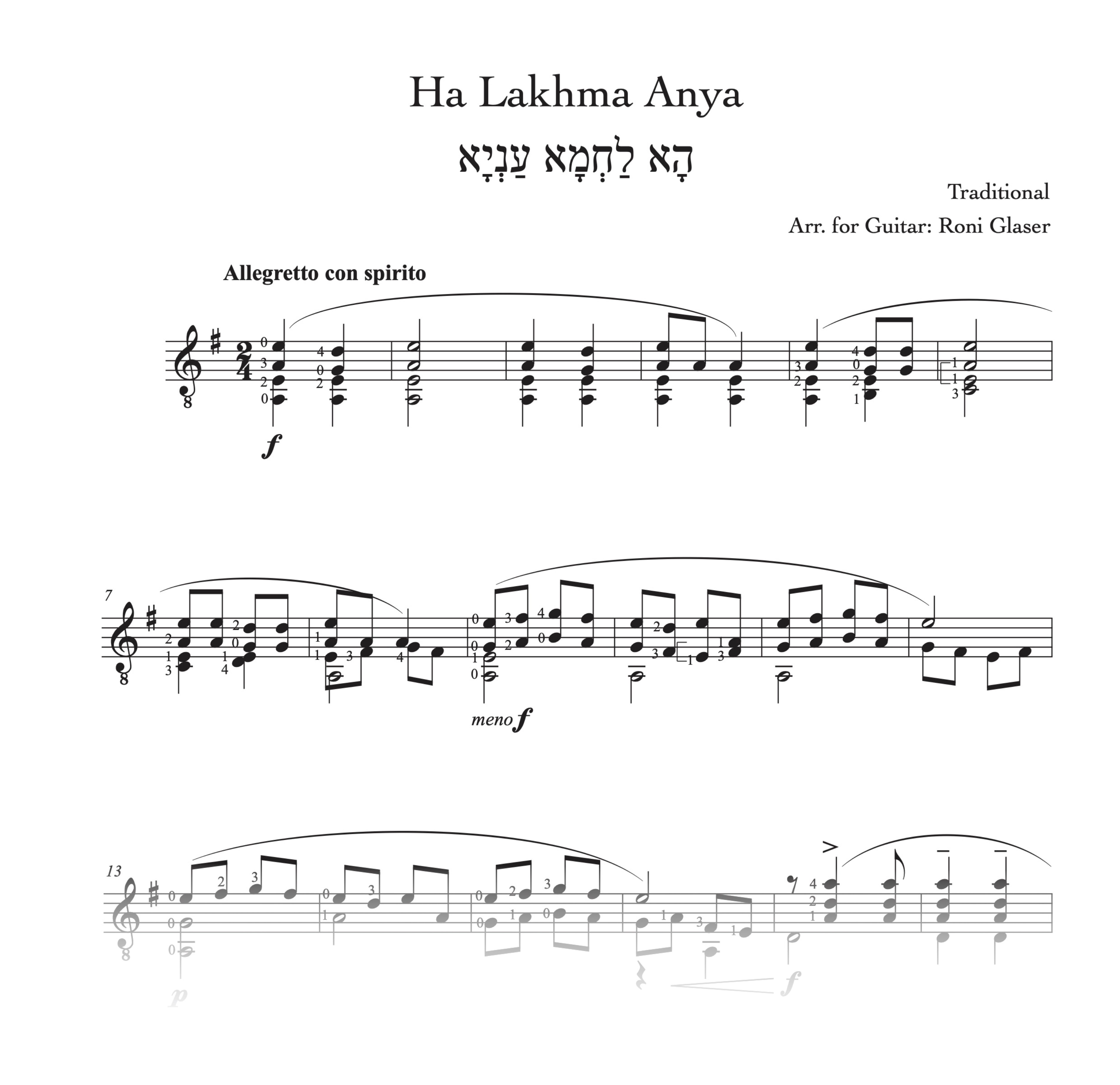Six-part canon for solo guitar (video)
Welcome back. This week you can hear me playing the six-part canon, the first one in the series of canons I told you about last week. You can see the score here too.
Reflections
Successes
While I did indeed write this as an exercise of what I thought would be the maximum number of voices the instrument could handle, a canon has no musical value if it is just a canon for the sake of a canon. And so I’m pleased to say there are some things I like about the piece musically:
- The sombre mood created by the melody and the harmony;
- The harmony – although I more or less just created it from whatever notes my fingers could reach and is a bit tricky to pinpoint tonally, it doesn’t feel unnatural to me;
- The arc of development of the piece – the way it grows and declines;
- I liked my idea of taking advantage of the guitar’s natural tuning by making it a canon at the fourth (i.e. the melody in each new voice is at an interval of a perfect fourth above the previous voice), and limiting the range to the first four frets of each string, enabling each voice to remain on each string, and the piece to be playable;
- I was actually able to play it;
- It also has the climax at exactly the golden section, that is, at 0.618… of the way through (approximately). It definitely counts as on purpose, seeing as I’ve made the conscious decision to leave it like that after noticing it…
Shortcomings
The tight technical restrictions did still make it difficult to bring as much musicality to it as I might like in a few areas:
- The melody of the canon didn’t have much in the way of characteristic motifs, other than the first bar or two, and after the third bar the notes were used almost purely for the harmony, and so that it would be a canon with six voices sounding at the same time. By the time the fifth voice entered, I was basically too limited by what my fingers could do (and by the fact it was a strict canon) to make the voices do any more than play an open string;
- Some of the chords have stretches that are almost impossible for me, and might be too difficult for other people.
- I might have liked the piece to be a bit longer, but this wasn’t possible because I didn’t manage to give the melody enough interest due to the restricted range of a fourth, and the lack of characteristic rhythms, thus there wasn’t much scope for development.
- I would’ve liked it to repeat, i.e. for it to go back to the beginning and feed into itself like canons often do. I tried various ways to get it to repeat, but it ended up being either impossible to play for the left hand, or I didn’t like the harmony. I’ll try again in future canons.
Lessons learnt
Although this is only a small piece, I still found a few useful things to help me in the future when composing or playing the guitar:
- As I mentioned, the range restriction was helpful to make it more playable. It is, however, hard to create characteristic melodies with such a small range of notes and little in the way of rhythm. I think if I’m crafty, I could use the restricted range at certain points in a piece and expand at others to balance musical interest and playability;
- If the left hand is too full, characteristic rhythms could be created by just repeating notes (I didn’t do this in this canon);
- There’s a lot to be said for not restricting the harmony too much and simply taking whatever notes are available. If you’re careful and understand the kind of chords, interval schemes etc. you’re using, it can be effective and coherent;
- On the guitar playing side of things, this canon has been a great exercise for me in legato playing with chords, i.e. linking the chords together so that the changes are smooth. Since it’s important for the melodic lines to be as legato as possible, you can choose to hold particular notes that stand out more while releasing the fingers on less important notes in preparation for the next chord. In this way, there is an illusion of legato because the sound doesn’t stop completely between chord changes and the melodies are maintained better. You can also spread chords (arpeggiate them) so that you have the fraction of a second necessary to move your fingers to the higher notes.
Next
I’ve been planning to compose this canon series counting down from six to two voices repeatedly, so the next canon would be for five voices. But on the other hand, I often like to compose pieces that are opposite in character to the one I’ve just written, so I might do two. We’ll have to wait and see. Watch this space!
A New Project: The Guitar and Counterpoint – Canon for Six Voices for Solo Guitar (Score)
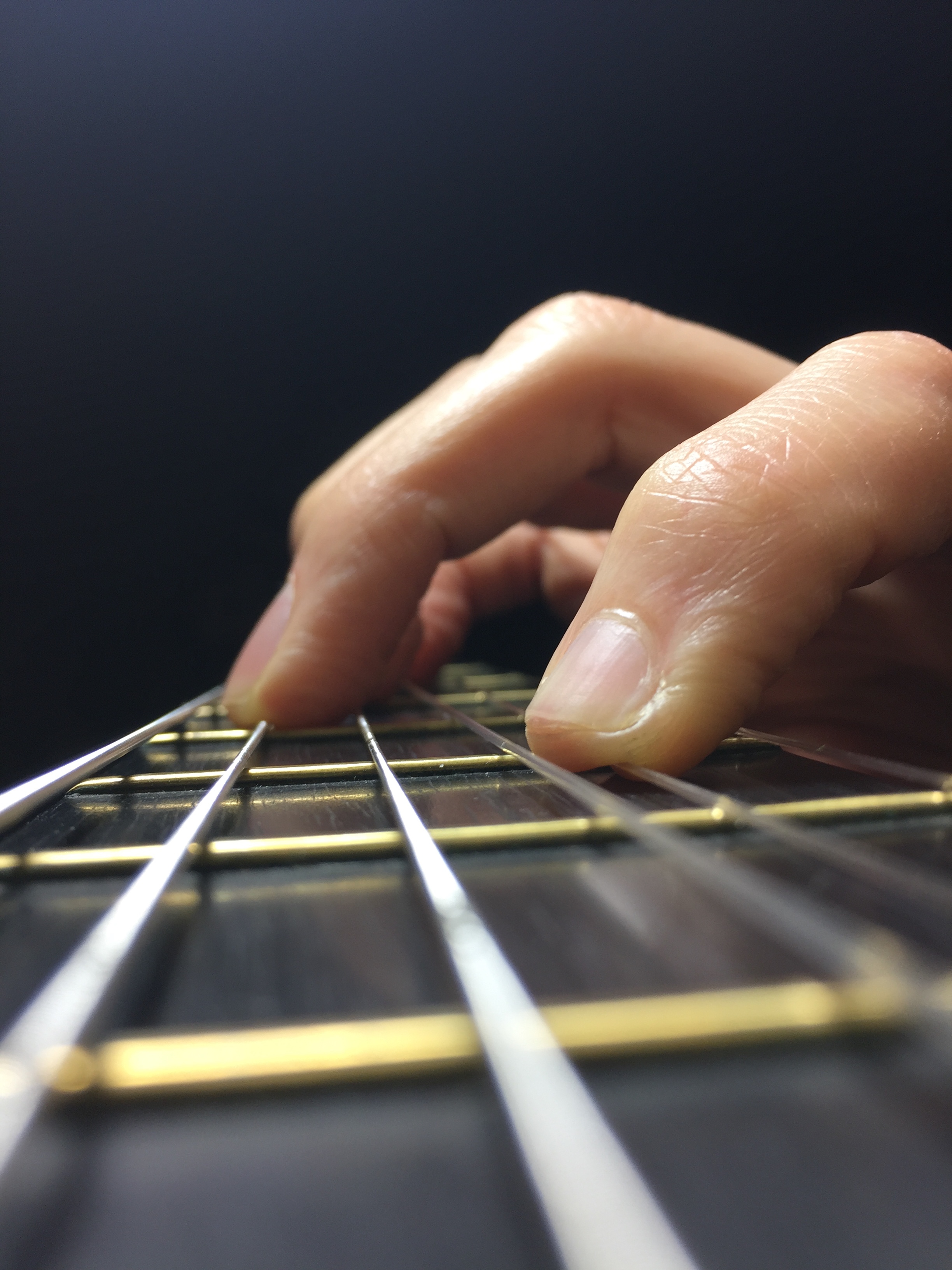
As part of my efforts to develop my writing for the guitar, I’ve begun a new composition project to explore a particular area. It’s nothing new on the guitar or in music, but it’s one of my favourite things, and something that I take great delight, as well as pains, in playing and composing. This is counterpoint.
In this week’s post I’ll tell you about this project. I’ll discuss counterpoint and what it is briefly, the difficulties the guitar has with it, and finally the score of the first composition.
Counterpoint indeed.
I like counterpoint.
As well as liking it, I want to be able to write contrapuntal music that feels natural on the hands and doesn’t make the left hand look and feel like it’s playing Twister at breakneck speed.
Contrapuntal composition is already something rather complex, since the strict rules in some styles often mean you’re left with very few notes to choose from, and then with the further limitations of the guitar, you can be left with no music at all.
So I’ll begin with a short discussion on what it’s like playing and writing it on the guitar, and then show you the score of first step in this project.
What is it?
If you don’t know what counterpoint is, it means music with several different melodies played at once, often with strict rules governing how they intertwine with one another. “Contrapuntal” music is also sometimes called “polyphony”, many (i.e. at least two) voices singing together, perceptible independently and as one. As well as voices, contrapuntal music works with several instruments playing together, or with one like the piano that can play several notes at once. It’s also supposed to work on the guitar…
I won’t bore you with any more explanations or with why I like it, because it’s better if you experience it, and I very much hope you get the chance to do so.
Composing and playing
Where it gets tricky
The guitar with its six strings – you’d expect it to be quite suitable for counterpoint, wouldn’t you? Well, yes, but we do only use four fingers on each hand. Still, that should be enough, shouldn’t it? Yes, but you generally use one finger from each hand per note, and when one note follows another, you generally want to use a different finger, just like you prefer to use the other foot for your next step when you’re out for a walk, otherwise you’d be out for a hop. So four divided by two leaves us with enough fingers to more or less comfortably manage two melodic lines. Two-voice counterpoint is all well and good, but it never really gets interesting unless there are at least three voices; we’re two fingers short of a fugue. Poor guitar, poor guitarists.
But wait, there’s more to the guitar than that – guitarists can also play on open strings, use all manner of barrés, play several notes with the thumb etc. etc., so maybe there is hope?
Yes, it certainly is possible, but the composer and guitarist are practically handcuffed in the limitations we constantly work under. To illustrate it rather bluntly: the guitar, with its wonderful palette of timbres, has been described as an orchestra in miniature. This is true, but in this orchestra it’s like the entire string section gets their left arms hacked off temporarily whenever there’s a clarinet solo.
The rules of counterpoint are severe enough already, surely any more limitations will just be suicide? Well, it seems we end up having to find a way to use just the string players’ right hands, or carefully and musically craft the amputation so audience doesn’t notice.
Apologies for the graphic analogy, but hopefully you might know what I mean. They do get their arms back in the end.
The project
Canons
One of the projects I’ve been thinking about that I mentioned last week is a series of canons. The other piece from the last few weeks will make a return at some point (along with the other movements), but once it’s more polished and I can play it all for you.
To begin with, I’ve decided to write a series of canons for the guitar that I can actually play. I’m going to write different canons for different numbers of voices. Just for some numerical fun and to force me to be creative with my solutions to problems, I’m planning to write 2 canons for 2 voices, 3 for 3 voices and so on up to 6 canons for 6 voices – the number of strings on the guitar. The 6 are probably borderline impossible, but the challenge will be interesting.
First attempt – Canon for Six Voices at the Fourth
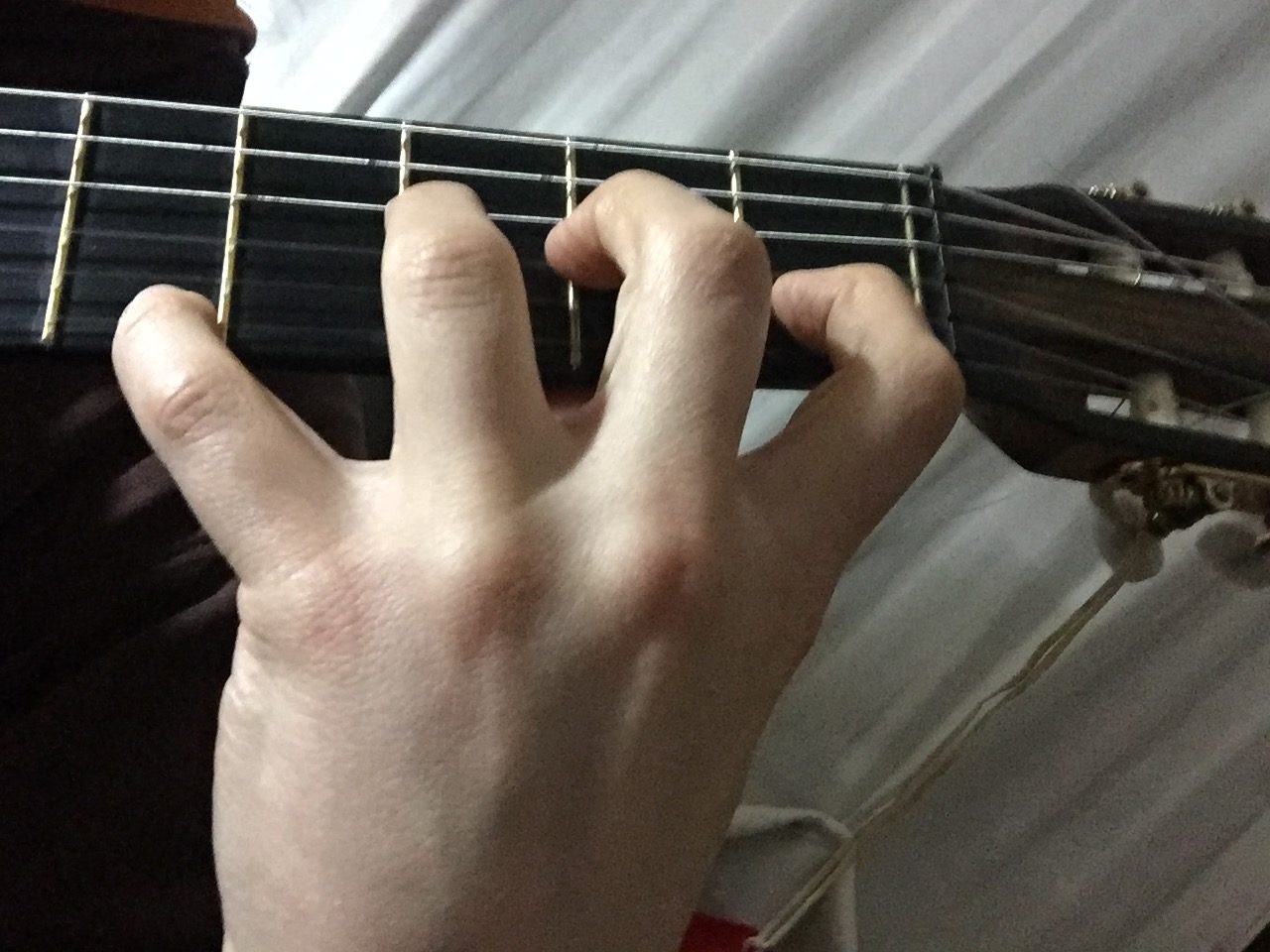
Click here for the score of the first canon.
With six voices on six strings, I jumped in at the deep end, but it was the most interesting-sounding challenge. I used a few tricks to keep things as simple as possible.
Some points about how I wrote it:
- I’ve written it on two staves to facilitate visibility. I hope you can read bass clef.
- To simplify the technical side a little, I designed it so that each voice occupies its own string.
- It’s a canon at the fourth, i.e. each voice enters at an interval of a perfect fourth above the previous entry. This makes use of the guitar’s tuning – the strings are a perfect fourth apart, except the highest two. To maintain musical rigour, the six entries all begin a fourth apart, rather than simply on the first note of each string, which does make it more difficult to play.
- The melody is sombre and very simple, and each voice remains within the range of a major third, i.e. one less than the aforementioned perfect fourth, in order to avoid crossing voices and the technical complications that this entails. The guidelines of counterpoint indicate that melodic lines should span at least a sixth for the sake of interest, so a third could end up being boring. There are, however, two semitones in the melody, which I think gives it an interesting tension.
- The harmony is relatively free, and to my mind sounds like Gesualdo at times. There are things like suspensions, but not resolved according to the traditional rules. I pretty much just went with whatever was available on the fretboard and sounded interesting and acceptable to my ear, which I think has developed into it’s own characteristic sonority.
- There aren’t really many jumps from one difficult chord shape to another, and voices often move by fingers just sliding up and down the strings.
- There are some pretty diabolical stretches in the left hand, specifically bars 5 and 6; perhaps I should warn you that my hands aren’t all that small, but my left hand is really at its limits here. There is the possibility of tuning strings 1 and 2 up a semitone to C and F respectively, but that is not without it’s complications in other places too.
There. A first short and almost simple canon. I did want and try to make it go up in fourths continually so that it goes round the circle of fifths and all twelve tones and then starts again at the first E, but that turned out a bit too tricky for me right now. Maybe next time.
Next week’s post
Next week I’ll play it for you. Watch this space!
Comments and questions
I’d be very interested to hear about any of your thoughts about composing or playing contrapuntal music on the guitar, and of course any comments or questions you might have on the subject.
Let me know if you have a go at playing the canon too!
2019 – The Road Ahead
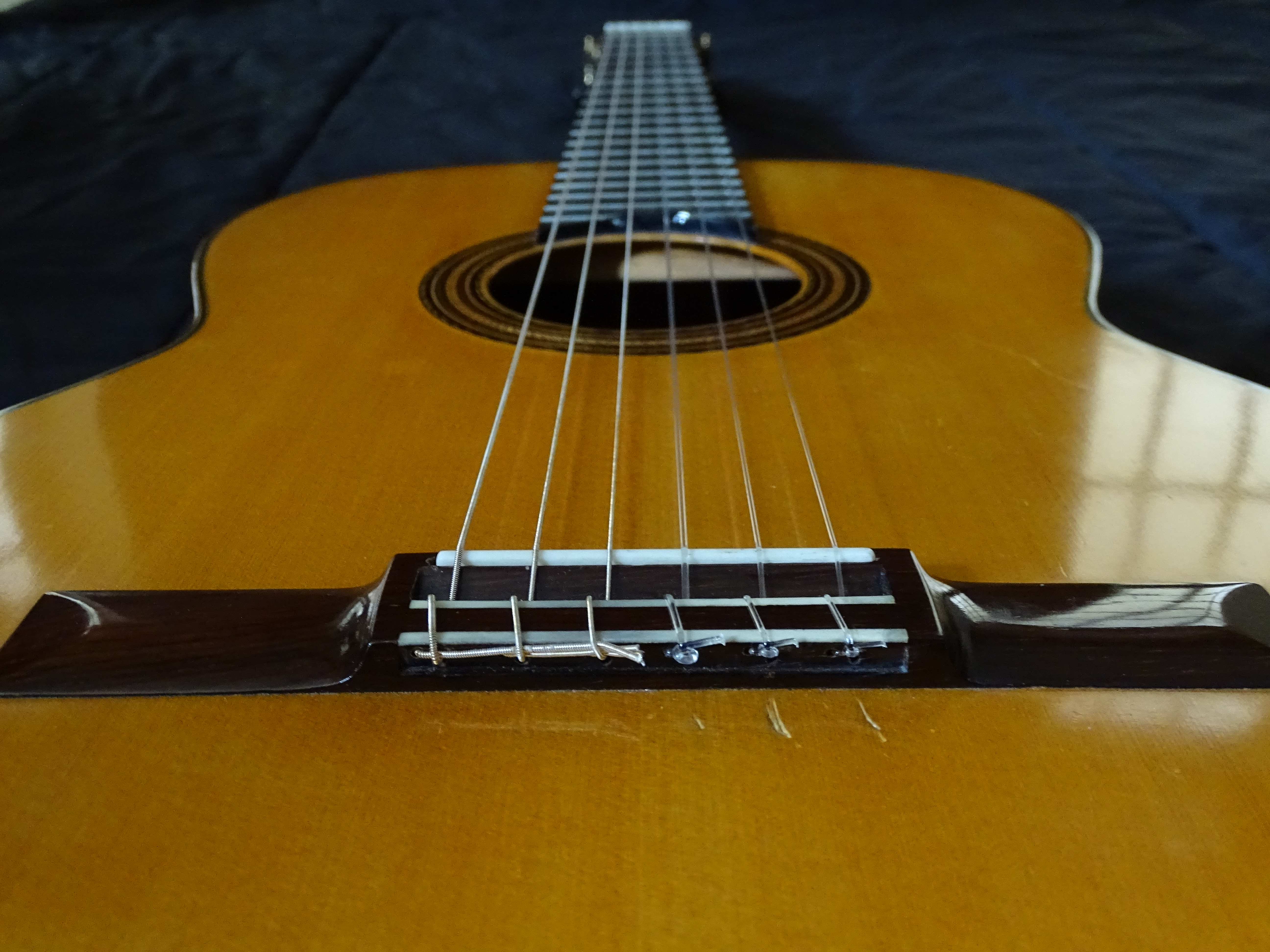
A very happy New Year to you, and thank you for visiting.
Since this is the first post of the year, I’d like to briefly talk about some plans for writing more guitar pieces.
2019 seems rather open and uncertain in terms of how things might develop for me, but I have some achievable ideas for solo guitar pieces, which you can of course expect to see right here on this blog.
Plans, plans, plans…
Apart from finishing off the multi-movement piece I’ve been telling you about in the previous posts, I’ve been thinking about several open-ended exploratory projects, each of which would most likely involve writing several pieces. In them I intend to develop my composition and playing in the particular area that they focus on. The first being:
Counterpoint
I really like contrapuntal music, especially with three or more voices, but playing it on the guitar can sometimes be quite taxing, and composing it even more so. And then playing what I write? Well, that can be nigh on impossible.
But it doesn’t have to be this way! So, I’m going to write a series of pieces of different kinds of counterpoint to develop a good understanding of what works well technically and musically on the guitar:
- Canons for 2, 3, 4, 5 and 6 voices (for solo guitar)
- Fugues
- Something else
- If all else fails, back to basics with species counterpoint.
Probably sometime after or in between doing some of these, I want to explore…
Rhythm
Studies in rhythm
I also really like rhythm, so I’m thinking about composing a series of pieces that look at particular aspects of rhythm and how they function. I’d like to do this in a slightly formal way, looking at things like pulse, accents, polyrhythms or tempo modulations.
Guitar percussion
Going beyond the strings, I want to write some pieces in which I hit and tap the guitar, or use other unpitched sounds. I essentially want to do this to make rhythmic music, as well as broaden my expressive palette on the instrument.
I’m also thinking about doing hommages to Gregory Coleman and Clyde Stubblefield, of “Amen” and “Funky Drummer” fame respectively, for a bit of fun.
Prepared guitar
By this I mean either with something stuck to the guitar, or played with a foreign object in some way. It’s an obvious way to do something non-traditional, which is my intention, but I’m sure it’ll be fun, and that’s the point. There’s probably a whole world that could be explored here, so we’ll see how it goes.
10-string guitar
Some months ago my uncle David bought me a 10-string guitar. It’s quite difficult for me to explain to you how astounded and grateful I was and am for his generosity, but it seems to have manifested in the form of music.
I can’t deny how just thinking about having a 10-string sparked off ideas about what I could do and compose on it, which is in turn partly responsible for me becoming more active with the guitar in general. Even before receiving it, it had got me working on a few pieces for the 6-string just to satisfy the creativity.
So far, I’ve managed find my way around the massive fretboard and get to know the instrument better, but there is still plenty of headway to be made.
Tunings
The first problem I encountered on the 10-string guitar was the tuning. People use various tunings, none of which I’ve been satisfied with personally, but all of which have given me good ideas about what to do for my own tuning. I’ll tell you about them in a blog post or two.
Transcriptions and compositions
I’m hoping to be able to play some music that isn’t possible on the 6-string, so I’m planning to look for some pieces to transcribe, probably from keyboard instruments. You might see some compositions at some point, but most likely only after a good deal of exploration.
Other
Apart from projects, there are some other things I’ve been thinking about doing on the guitar:
- Write little pieces with anything I chance upon from my just playing around with the guitar that I like the sound of.
- Write some far out stuff.
- Write something really pretty.
- Practise improvising based on the musical principles of the different pieces I write.
- Play some graphic scores.
- Learn some Leo Brouwer pieces.
- Develop my tone.
- Develop my right hand speed.
That’s probably enough to keep me busy. And that’s composing just for the guitar…
Comments
Thank you very much for reading, let me know what you think and if you’re interested in any particular areas. Help yourself to the box below, or find me with one of the round icons right at the bottom of the page.
Compositional Aspects – Movement II – Guitar Piece
Hello once again, and welcome back.
Notes on this week
Guitar
Since last week I’ve mostly been practising this second movement of the guitar piece I’ve been writing. I haven’t made enough progress since what I showed you last week for it to merit another video, but I’m a lot more secure with it, which is nice.
That’s the thing I like about practising, it works. Progress can vary, but you always notice a difference, however small.
I haven’t played or practised my own music this much before. The piece is within my capabilities but also challenging, plus I like it, so it’s fun and quite motivating, both in guitar playing and composition.
Composition
I haven’t quite had the occasion now that it’s Christmas to make much written progress in composing the other movements, but they continue to develop little by little in thought. I’ll hopefully be able to show you the beginnings at some point in the not too distant future.
Notes on the notes
After last week’s preview of what the guitar piece I’m writing sounds like, I’d like to show you some of its harmonic aspects. With respect to harmony, I’ll also discuss some thoughts on writing for the guitar, and what I see as the problem of flexibility of musical material. Lastly I’ll show you the tuning I’ve used, and how I’ve designed the melody.
It might get a bit technical, so let me know how you find it, and feel free to ask me anything.
Choosing notes
For this piece, I’ve chosen to use a harmonic and melodic scheme, i.e. how I’ve chosen the notes, that affords me a good deal of flexibility. There are reasons for this, so I’ll explain why and show you my solution.
The problem of flexibility
The guitar has all too often presented me with the problem of allowing me to write harmonies and counterpoint that sound fantastic to me and are wonderfully playable for a couple of bars, but alas, it rarely lasts. I try to take the idea further, develop it in some way, but the idea is too complex; the chords I’ve chosen are impossible to play in different positions, or I can’t play combinations of melodies in the configurations I want.
,This is obviously not the guitar’s fault, but the instrument can often handle a variety of textures and harmonies well, so it can be tempting to try and write things that just end up being too complicated. It’s somehow easy to forget that I’ve only got one left hand to fret the notes with. The onus is therefore on me as the composer to know the instrument and what works on it well enough to allow me to compose the music I want.
Solutions
Here’s what I’ve done in this piece to solve this problem.
Harmony
The harmony is essentially fairly simple, I just used intervals I wanted around open strings to define the sonority, mostly minor 2nds and 3rds, rather than particular chord schemes, to give me the freedom to make things technically a lot easier.
It often serves the function of providing more notes when the tension in the music requires it, and since the rhythm is very important here, it’s used for punctuating rhythmic accents, or at a climactic point.
The fingers dictate the harmony
The harmony I’ve used is very much dictated by what was comfortably available to my fingers and didn’t require much effort for me to play. I just worked with whatever notes were easy and comfortable to play, and if they didn’t sound too classical, that was enough.
I’ve heard a similar theory to describe flamenco harmony, such as when a barré (a technique which can requires a bit of effort for some) is left out of an F major chord, adding an extra augmented 4th and major 7th (the open B and E strings). The result is a very characteristic chord, and thus less effort equals better music. Hurray!
Open strings – tuning
I wanted to use certain intervals more than others in the harmony, so I used a scordatura of Eb (semitone lower) A D F# (semitone lower) Bb (semitone lower) E. If you don’t want to write in the classical harmony that the tuning was basically designed for, then it makes sense to change it.
I must admit I didn’t experiment all that much with it in terms of finding chord shapes and scales, I just chose some notes I liked and then started writing. The intervals were important in my choice though.
The two tritones between the top and bottom pairs of strings at an interval of a minor 9th are quite characteristic here, with the D a major 7th above the lowest note.
I like the mood the open strings have just by themselves. The three bass strings also sound pretty fat together. Have a listen:
The open strings are also very important notes in the grand scheme of things, especially the three basses. Why? On the one hand I could say that it’s because the harmonic scheme relates these pitches in the global structure of the music, the A largely functions as the tonal centre of the piece, with the Eb as a kind of Bartokian dominant, and the E#/F#, D as other tonal centres. But on the other, it’s because open strings are easy and don’t require much effort, and because they worked in ways that I liked at particular points in the piece. Basically I worked with what’s there, meaning what the guitar, as well as me, can do. Thus the musical material comes out of what’s there first, rather than imposing preexisting theoretical ideas.
Melodic scheme
Rather than a singable melody, I’m looking more for faster rhythmic movement, something towards spoken language. For me, this doesn’t mean there’s any sacrifice of expressiveness. I like the qualities of phrasing that can be found in the articulation of a minimal amount of notes, with sparing and careful use of certain notes.
Notes used
As before, flexibility through simplicity is key here. I’ve basically used groups of four notes, which are a minor second, major second and minor second apart, as in the first couple of pages: E# F# G# A, with a sort of base or tonic of E#/F#, tension with G#, and a climactic on the fourth note, A:

You can also hear me improvising with this in the video from a couple of weeks ago.
I obviously go beyond this four-note range and change it slightly. For example the major second in the middle becomes an augmented second. There are also a few runs, with one from the lower register to the top; to maintain the sonority I used a scale with a few rules:
- Never two whole tones in a row
- Never more than two semitones in a row
- About one augmented second (three semitones) per octave, always with a semitone on either side.
Phrasing the with minimal notes
I should mention that György Ligeti’s Musica ricercata II (as well as the analysis of my teacher Francisco Martín Quintero from when I studied in the conservatoire) was very important in guiding the phraseology of the first page, and how to use two just notes to good effect. I swear I didn’t choose the same E# and F# on purpose. Honest! They just fit nicely in relation to the open tuning and their position on the bass strings, and I like the slap of the strings against the fretboard with the hammer-on from the open string. Plus they’re two of my favourite notes.
Next Time
Right now it’s the holidays, so it’s difficult to predict what I’ll have been able to do by next time. Hopefully I can play you some more, show you some of the other movements, or even something else… Watch this space!
Comments and questions
As always, let me know if you have any comments or questions with the box below, or find me with one of the round icons right at the bottom of the page.
Movement II – Guitar piece (draft score)

This time I’ll show you how I’m writing some of the second movement of the guitar piece I told you about in the last post, and let you see the first draft:
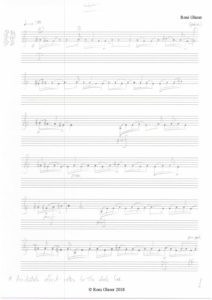
The notes
This blog is LIVE, that means you see what I’m writing as I’m writing it. So far I’ve done a first draft of the second movement. You can see it, warts and all, here. It’s not the finalised thing, so you can see bits of annotations about plans, corrections or uncertainties around the notes.
I’m showing it for general interest, and if anyone has any questions or comments (see below), it would be great to hear from you.
I imagine some of you would rather hear it first, but usually nature dictates that learning to play a piece comes after it has been composed, especially if the piece ain’t that easy. You can hear a tiny bit of me messing around with the basic material below, but I’ll do my best to try and play some for you properly next time.
The state of play
As I mentioned, this is a first draft, and it’s as far I’ve got on paper. A few things need to be sorted:
- I need to be more sure that I’m happy with the use of the thematic materials, and there are some that I think could be developed more, either by adding more music, or reworking some bits.
- The notation – the duration of notes could perhaps be more consistent. I might also add some barlines, time signatures and phrase markings to make it easier to see the structure of things. I’d do this when I do a computer version.
- General checking of finer details.
Composing the piece
Starting with the second movement
I’ve started on the second movement, basically because I intended the first and last to be related to the other movements in some way and carry a fair amount of semantic weight, so I began with a different movement to see how things grow from there.
The musical idea of the beginning came to me first, and I felt from its character that it wanted some kind of prelude before it.
Character
As I began to mention last time, here are some of the ideas I have in mind about the character of this movement:
- Rhythmic, with a strong sense of movement
- Quite fast
- An improvised quality
- Smoother and with more flow than the other movements
Guitar technique
I intended to write a very “guitaristic” piece, which for me means one that is natural and comfortable to play on the guitar and minimises the awkwardness that can arise from technical difficulties of a musical idea played on an instrument that it is not necessarily made for.
This essentially means messing around with the instrument and using ways of playing that I like the sound of. Of course, an instrumental technique is not music, but there is no reason why you can’t make a good piece of one.
The basis
I was basically just doing something along the lines of this:
and decided to make a piece out of it.
Techniques
With the left hand, there are ligados (“hammering-on” or “pulling-off” without plucking with the right hand).
With the right hand, there is the use of notes mostly played with the thumb interspersed with open strings, in much the same way as the famous “Asturias” by Albéniz, or Leo Brouwer’s Estudio Sencillo No. 1.
Putting these together, I was able to design an interesting line using just two notes, but varying between ordinary plucking with the thumb, ligado, and an open string. I like how the articulation can be used to vary the accents to rhythmic effect. If you are a guitarist, you’ll know that with a ligado you usually hammer-on or pull-off with the left hand straight after you’ve played a note with the right hand. Here, however, I’ve put other notes played with the right hand between the ligado notes to facilitate the flow of the articulation.
The resonance of the open strings in the melodic line also edges towards the campanella effect, in which notes are played on different strings to allow them to continue to resonate, as bells might. Church bells obviously aren’t as fast as this piece – here I’ve used it for the articulation and the atmosphere it creates.
To be honest, it’s actually a bit confusing, because often the pitch of notes is not in the order of the pitch of the strings. I’m hoping I (and whoever might do me the honour of trying to play this piece) will get over with time, and that it will help to increase mastery of where the notes are on the fretboard.
Next time
Next time I’ll play some of it for you, and talk a little bit about how I’m going about learning to play the piece.
Comments and questions…
… are very welcome, so help yourself to the box below, or send me a message with one of the icons below.
If you’re a guitarist, you could have a go at playing it yourself… do be sure to let me know how you get on!
Guitar piece – untitled (as yet)
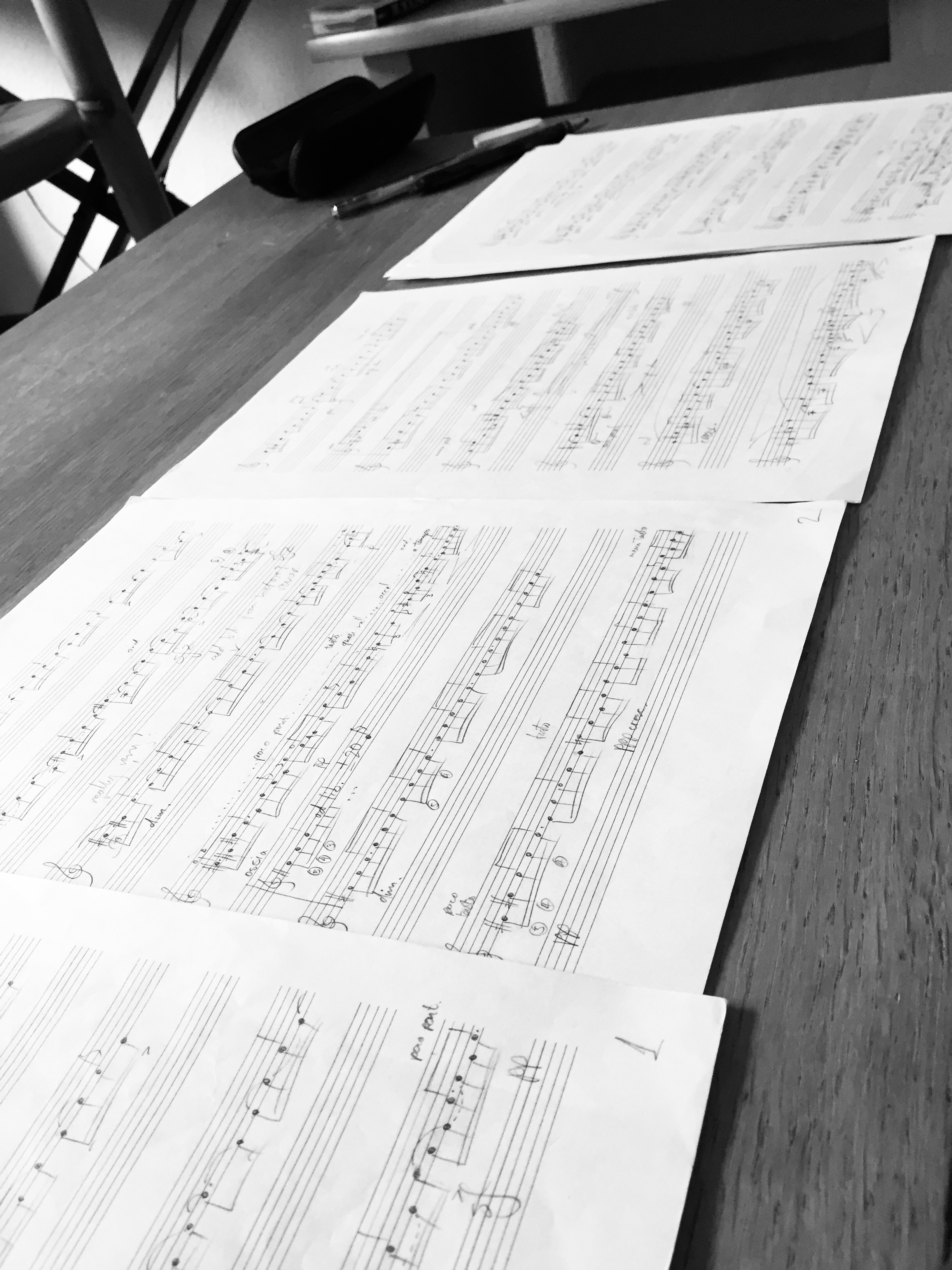
Right now what I’m writing as I’m writing this blog is a solo guitar piece.
A longer piece
I’m basically writing it because I wanted to compose a longer piece for the guitar than the ones I’ve often seen. I used to feel that there were too many short pieces of not much more than a page or two, or pieces like suites with several shortish movements. While the guitar’s repertoire has expanded greatly and become enriched with all manner of styles in the last decades, my desire for longer pieces still remains.
Ideas
I think I mentioned in a previous post that I thought it was time write some serious guitar music. This is more or less the beginning of that.
The most important thing here then is to write something – this means that rather than taking months to go deep into my artistic psyche and soul, contemplating how to explore the timbral qualities of the instrument and brooding upon what this piece might say about me as a composer in this world in 2018, I’m going bash out something that has more of an improvised quality and is fun to play. We’ll see. Sometimes preventing rumination on single notes is impossible.
I also want to write pieces I can play, which helps to add a dimension of technical realism to it, i.e. not write things that are too difficult, and thus increase the chance of other guitarists being able to enjoy it as well.
Several movements
I found myself thinking “multi-movemently”, with the urge to compose a piece with about four or five separate parts that were different in character. I’m not about to write another suite though, I hope, and I reckon there are enough already – at least four that were good enough not to mess with. A sonata might be closer to how I was thinking, but I wasn’t about to start meddling with sonata form – there’s probably been enough of that too. The important thing is just to compose with the sort of musical character and materials I had in mind.
Four or five
The structure of all the movements in terms of their character will basically be:
- Fast and rhythmic, brutal
- Quite fast and rhythmic, smoother
- Slow and intense
- Humorous, somewhat erratic; moderate tempo.
- Faster and rhythmic, brutal
Character
You might have got a sense that the element of “force” figures here, you might have noticed that the word “brutal” appears twice. Probably something to do with the fact that I like music like that, but also with the intention of going beyond the intimate, delicate, nice and gentle character that the classical guitar tends to have. Not that I want to stop the guitar being like this, it’s just I want more badassness in the repertoire.
Next time
In the next post I’ll tell you about some specifics of how I’m composing the second movement, which is where I’m starting, with some of the sheet music too.
A Narrative
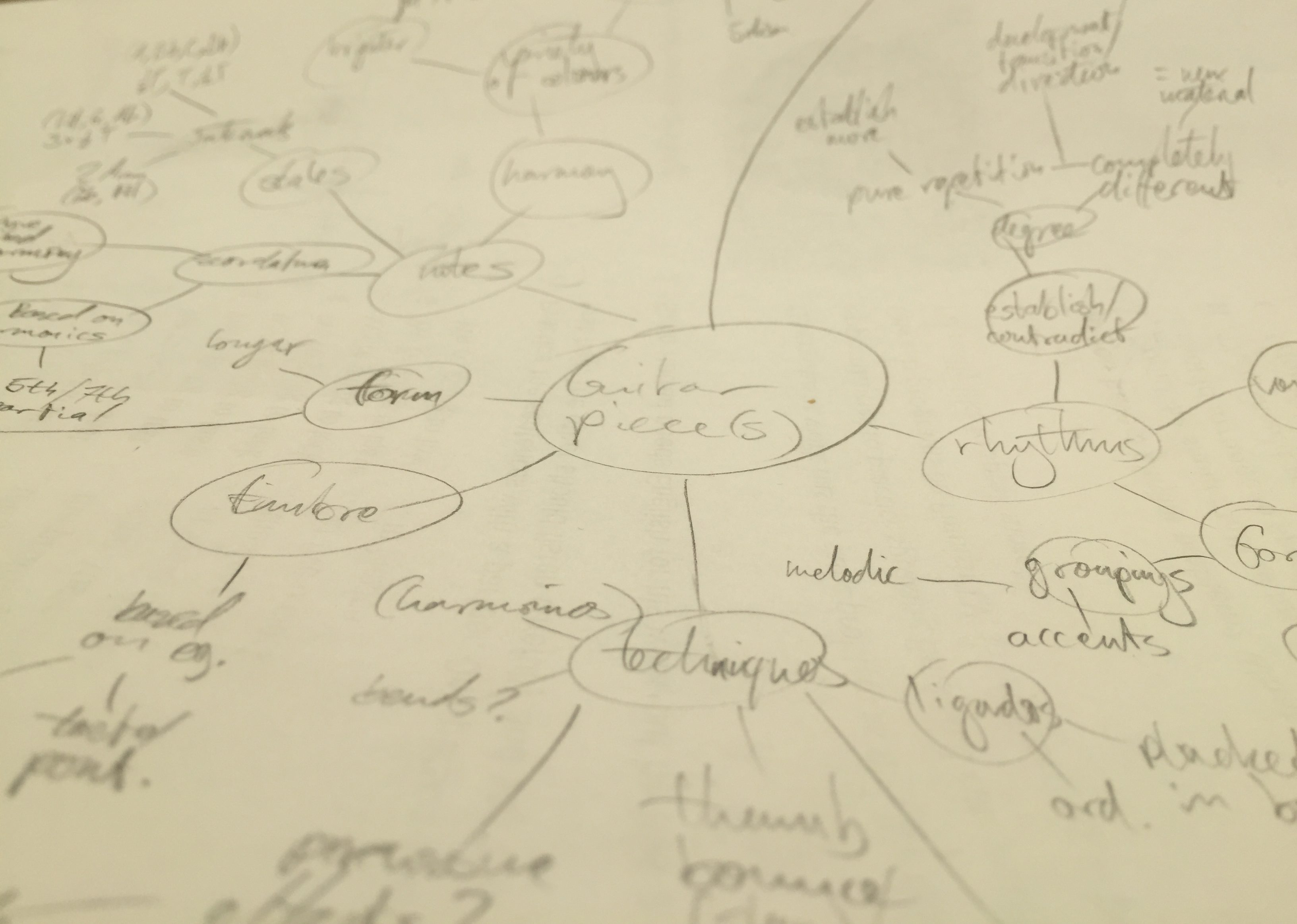
Here begin the chronicles of my musical compositions. This is far from the beginning of my journey into music, but the start of me documenting it so closely.
The final manifestation of the finished piece when it’s performed on stage is only a fraction of what goes into it, and I believe there is value in sharing this with you.
Each post is a chapter in this narrative, and with me you will follow the evolution of a piece of music from the ideas that give birth to it, through its gradual manifestation in note form, its successes and failures, to it being brought to life in performance.
As it moves from its infancy to maturity, changes are made, obstacles are encountered, and there are troubles and triumphs. I hope that by showing you how a piece progresses towards its finished state, we can all learn together.
Composing for the guitar
The instrument I am referring to is usually called the “classical” guitar. Although I love composing for any kind of musical medium from the most minimal to the enormous, the guitar is what you’ll most see here because:
- The “classical” guitar is my instrument, and the one that has followed me round the world for the past 25 years or so.
- With it I can show you the entire process of a piece of music being brought to life first-hand.
- For those less used to reading scores, I can play it for you, and the one-stave format is also reasonably easy to follow.
- The guitar is an instrument that is difficult to compose for if you don’t play it yourself. Rather than just follow a manual of dos and don’ts, you can learn from how someone who is a composer and guitarist tackles the whole process.
- Most importantly for me, I feel I owe the guitar a serious body of work.
Considering the years I mentioned, I am still only really at the beginning of my journey as far as writing for the guitar is concerned, with just a handful of pieces and transcriptions. I did write a piece for guitar and orchestra that was performed in the Córdoba Guitar Festival in July 2012 though: “From Shimmers on Dust Clouds”, played by the very talented guitarist María José Tirador and conducted by Ciro Perelló with the Young “Leo Brouwer” Philharmonic.
Now it is clear that it is time for me to develop a serious body of work for the instrument. I invite you to share this journey with me, learning with me from what we discover along the way, and very much hope you enjoy the music.
Next
The next post includes the score of the first part of the first piece you’ll see and hear chronicled in this blog and why I’m writing it. It will be a piece for solo guitar with several movements.
-Roni
Introduction
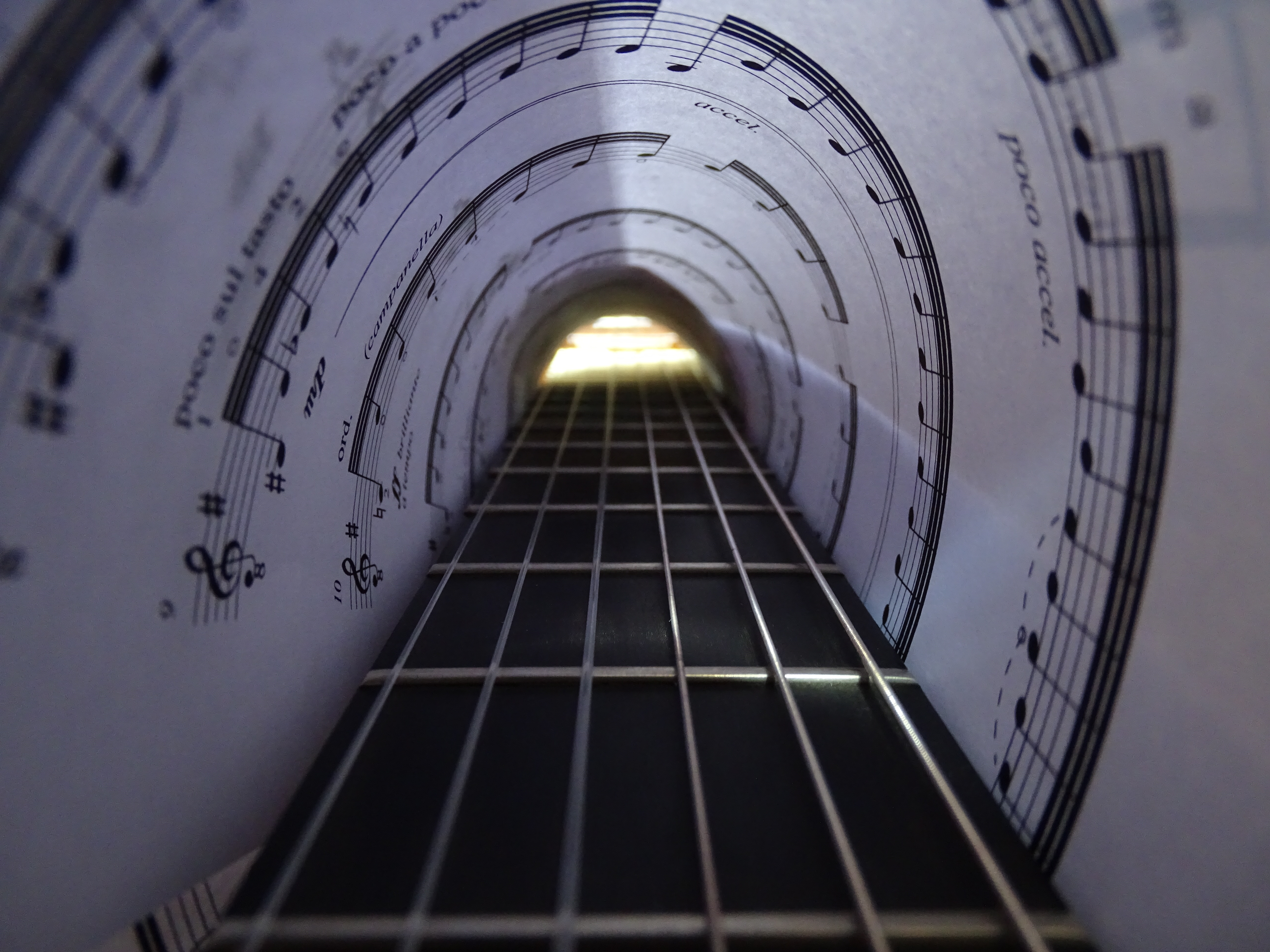
Music lovers, guitarists and composers, welcome.
This blog is about showing you how I compose music, and sharing it with you. My instrument is the guitar, so you’ll see posts on my compositions, my guitar playing, and things related both of general musical interest and more technical.
You’ll see the scores I write, with posts about how I’m writing them while I’m writing them, and the ideas that create them. I’ll also endeavour to post videos of them being played.
Music lovers – through the stories behind the music-making of how a piece is born what it has to go through until you hear it, I hope to deepen your enjoyment and appreciation of music and the guitar.
Guitarists – as well as regular posts of original scores, you see advice on how to approach playing the music with interpretative and technical details, both in written and video format.
Composers – you’ll see concrete examples with explanations and explorations of compositional technique on page and in performance. The music will mostly be for the guitar, allowing me to play it for you, and giving you the chance to see how writing works for this rather idiomatic instrument with its unique musical palette.
I very much welcome and would be grateful for your questions and comments about anything in this blog and the pieces from the simplest to the most technical, from general ideas to single notes using the comments box or links below. I would also be delighted to hear from you if you want to chat about anything related to the content here.
I aim to make a post once a week, so be sure to check back later!
The next post discusses some further points about the nature of this blog and how the guitar is involved.
I also very much hope you enjoy reading this blog as much as I do making it!
-Roni

